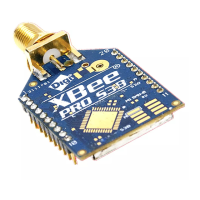Advanced application features Network commissioning and diagnostics
XBee®-PRO 900HP/XSC RF Modules
162
n To update only the routing table information without affecting the DH/DL registers, use
Example 2.
n To update the DH/DL registers of the network, use the method in the following example.
Example: Use the device with serial number 0x0013a2004052c507 as a network aggregator and
replace it with a device with serial number 0x0013a200f5e4d3b2. Issue the AG0013a2004052c507
command on the new module. This causes all devices with a DH/DL register setting of
0x0013a2004052c507 to update their DH/DL register setting to the MAC address of the sending
device (0x0013a200f5e4d3b2).
Place devices
For a network installation to be successful, installers must be able to determine where to place
individual XBee devices to establish reliable links throughout the network.
RSSI indicators
It is possible to measure the received signal strength on a device using the DB command. DB returns
the RSSI value (measured in -dBm) of the last received packet. However, this number can be
misleading in DigiMesh networks. The DB value only indicates the received signal strength of the last
hop. If a transmission spans multiple hops, the DB value provides no indication of the overall
transmission path, or the quality of the worst link; it only indicates the quality of the last link.
Determine the DB value in hardware using the RSSI/PWM device pin (pin 6). If you enable the RSSI
PWM functionality (P0 command), when the device receives data, it sets the RSSI PWM to a value
based on the RSSI of the received packet (this value only indicates the quality of the last hop). You
could connect this pin to an LED to indicate if the link is stable or not.
Device discovery
Network discovery
Use the network discovery command to discover all devices that have joined a network. Issuing the
ND command sends a broadcast network discovery command throughout the network. All devices
that receive the command send a response that includes:
n Device addressing information
n Node identifier string (see NI (Node Identifier))
n Other relevant information
You can use this command for generating a list of all module addresses in a network.
Neighbor polling
Use the neighbor poll command to discover the modules which are immediate neighbors (within RF
range) of a particular node. You can use this command to determining network topology and
determining possible routes.
The device sends the command using the FN command. You can initiate the FN command locally on a
node using AT command mode or by using a local AT command request frame. You can also initiate the
command remotely by sending the target node an FN command using a remote AT command request
API frame.
A node that executes an FN command sends a broadcast to all of its immediate neighbors. All devices
that receive this broadcast send an RF packet to the node that initiated the FN command. In an
instance where the device initiates the command remotely, it sends the responses directly to the

